India
healthysoch.com
New Delhi, October 19, 2019:
The meeting of the Emergency Committee convened by the WHO Director-General under the International Health Regulations (IHR) (2005) to review the current Ebola virus disease outbreak in the Democratic Republic of the Congo (DRC) took place on Friday, 18 October 2019, from 12:00 to 16:00 Geneva time (CEST).
Proceedings of the meeting
Members and advisors of the Emergency Committee were convened by teleconference.
The Director-General welcomed the Committee and thanked them for their support. He turned the meeting over to the Chair, Dr Robert Steffen.
Dr Steffen also welcomed the Committee and gave the floor to the Secretariat. Representatives of WHO’s legal department and the department of compliance, risk management, and ethics briefed the Committee members on their roles and responsibilities.
Committee members were reminded of their duty of confidentiality and their responsibility to disclose personal, financial, or professional connections that might be seen to constitute a conflict of interest. Each member who was present was surveyed and no conflicts of interest were judged to be relevant to the meeting.
The Chair then reviewed the agenda for the meeting and introduced the presenters. Presentations were made by representatives of the Ministry of Health of the Democratic Republic of the Congo (DRC), United Republic of Tanzania, Republic of Uganda, the UN Ebola Emergency Response Coordinator and the WHO Secretariat.
The current situation in the DRC was reviewed. As of 13 October 2019, a total of 3,228 cases were reported, of which 3,114 confirmed and 114 probable, of which 2,123 deaths (case fatality rate 66%). In the 21 days from 23 September to 13 October, the number of affected health areas has reduced, with 22 health areas and 10 health zones reporting new cases, predominated by Mandima, Mambasa and Kalunguta. The epidemic is currently concentrated in the Mandima health zone in the Biakato Mine health area. Priorities for the response include implementing a multimodal approach.
Uganda emphasized the efforts to vaccinate health care workers and strengthen community village health teams in the at-risk districts to enhance community surveillance. Uganda spoke about their approaches to rapidly address the EVD cases in June 2019, and highlighted efforts to strengthen preparedness, under the National EVD preparedness Task Force. Of note, Uganda’s surveillance system was able to detect numerous alerts of EVD suspect cases, with more than 1000 samples from across the country having been tested for Viral Hemorrhagic fevers (VHFs). Of these, 4 confirmed cases of Ebola were detected, 16 Crimean Congo Hemorrhagic fever and 8 Rift Valley fever. Also, strong cross-border collaboration, through regular screening at ground crossings and main international airport continued, which has enabled prompt follow up of lost high-risk contacts from DRC into Uganda.
Tanzania provided an update on their preparedness efforts, which continued since September 2018, through the Ebola Contingency plan, under the leadership of the National Task Force. Ten high-risk regions, were identified and supported to strengthen cross-border screening and raise awareness at health centers, ensure availability of personal protective equipment especially for health workers, strengthen public awareness of the disease through a toll-free hot-line, strengthen the surveillance system, and procure more than 2700 sets of personnel protective equipment.
Thermoscanners were distributed in high-priority points of entry (PoEs), given the porous borders with more than 700 travelers from the Democratic Republic of the Congo per week. From August 2018 to date, 29 alerts of Ebola suspect cases were reported, 17 samples tested and were negative for Ebola (including 2 in September 2019). Tanzania continued to practice simulation exercises in 5 out of 10 regions.
The WHO Secretariat provided details on the latest risk assessment. Risk remains very high at national and regional levels but still low at global level. In recent weeks, the incidence of EVD cases has consistently declined, with 15 new confirmed cases, reported in North Kivu and Ituri provinces during the last epidemiological week of 7–13 October, in comparison with 128 confirmed cases per week reported at the peak of the outbreak in April 2019. There is a shift in hot spots from urban settings to more rural, hard-to-reach communities, across a more concentrated geographical area. At present, 10 health zones are affected. These areas pose major security challenges. When response activities are suspended, the likelihood of underreporting and the potential for the disease to spread to new areas increases. In addition, continued transmission in remote areas where access is difficult creates the possibility of transmission chains going undetected.
The ring vaccination strategy is proving efficient and successful. Issues related to vaccine supply were reviewed. Given the uncertainty of the evolution of the epidemic, current supplies should be managed carefully. The Secretariat also welcomed the commencement of Johnson and Johnson vaccine studies in Uganda and the imminent commencement of similar studies in the Democratic Republic of the Congo, in addition to continuing to track progress with other vaccine candidates.
The United Nations Ebola Emergency Response Coordinator gave an update on the situation and efforts to maintain an enabling environment to improve access and acceptance of Ebola response in communities. He re-emphasized the need for stronger community engagement and access in all areas, increased multisectoral collaboration, and more financial and human resources. Insecurity remains the greatest concern. Efforts to increase security are underway. There is a need to focus both on intervention gaps and the quality of interventions. Identifying areas where the virus might migrate and securing these areas constitutes a major priority.
The Committee was also appraised by the WHO Secretariat on progress on preparedness efforts in the 9 neighbouring countries (priority 1: Burundi, Rwanda, South Sudan, and Uganda, and priority 2: Angola, Republic of the Congo, Central African Republic, Tanzania, and Zambia). Bilateral roadmaps for cross-border coordination between DRC and the priority 1 countries are being implemented. On 21 October 2019, a high-level ministerial meeting will be held in Goma, DRC, to further strengthen alignment and coordination of cross-border surveillance across all 9 high-risk neighbouring countries. A major challenge is the lack of funding for preparedness, particularly in the priority 2 countries. Of the USD66.6 million required for all the 9 countries, only USD4.5 million has been pledged. Compliance with IHR requirements for notification and verification of alerts was highlighted, in particular with regards to transparency and timely sharing of public health information.
Context and Discussion
The Committee commended the response to date, under the leadership of the DRC Ministry of Health, and appreciated the progress made under the multisectoral coordination commission established in July 2019. Support provided by WHO, UN agencies, NGOs and other partners has also contributed to limiting the spread and impact of this virus in a difficult context in many areas in DRC. The courage and commitment of all frontline workers were specifically praised by the Committee.
While the Committee commended the efforts made by the neighbouring countries to strengthen preparedness, it remained deeply concerned by the lack of sustained financial support for these activities.
The committee noticed with appreciation that the general compliance of all states with the WHO recommendations to keep borders open and air travel meant operations could continue and economies in the area were not harmed by border closures. However, the Committee is concerned that a year into the outbreak, the access and security situations on the ground could hinder final efforts to eliminate the virus from rural communities.
Conclusions and Advice
It was the view of the Committee that this event still constitutes a public health emergency of international concern (PHEIC) under the IHR (2005).
The Committee provided the following advice to the Director-General for his issuance as revised Temporary Recommendations under the IHR (2005).
For affected countries:
- Sustain the political commitment and multisectoral coordination approach to the response and expand this commitment to local areas and hot spots of the outbreak.
- Further enhance the acceptance, access and security situation to provide an enabling environment for all response partners to support public health operations as an essential platform for accelerating disease-control efforts.
- Continue to strengthen strategy, capacity, implementation, and coordination for community awareness and engagement, in particular in and around the current hot spots.
- Continue cross-border screening and screening at main internal roads, with a particular focus on routes connected to areas with current transmission.
- Accelerate comprehensive action for active surveillance for cases and unexplained deaths in all areas, with specific focus to detect all chains of transmission in hot spot areas and continue to implement real-time genetic sequencing of all new confirmed cases.
- Continue to implement optimal vaccine strategies that have proven maximum impact on curtailing the outbreak, as recommended by WHO’s Strategic Advisory Group of Experts (SAGE).
- Strengthen measures to prevent nosocomial infections, including systematic mapping of health facilities, targeting of IPC interventions and sustain support to those facilities through monitoring and sustained supervision.
- Strengthen preparedness in non-affected provinces of DRC, and more generally strengthen health system across the country to respond to concurrent health emergencies, such as the current measles outbreak.
For countries at-risk:
- At-risk countries should work urgently with partners to improve their preparedness for detecting and managing imported or locally-acquired cases, including the transparent sharing of detailed information on suspect cases, as required by the International Health Regulations (2005), and sharing laboratory samples of suspect cases for confirmatory testing in accordance with WHO norms and guidance.
- Countries should continue to map population movements and sociological patterns that can predict risk of disease spread.
- Risk communications and community engagement, especially at points of entry, should be increased.
- At-risk countries should continue to put in place approvals for investigational medicines and vaccines as an immediate priority for preparedness.
For all States:
- No country should close its borders or place any restrictions on travel and trade. Such measures are usually implemented out of fear and have no basis in science. They push the movement of people and goods to informal border crossings that are not monitored, thus increasing the chances of the spread of disease. Most critically, these restrictions can also compromise local economies and negatively affect response operations from a security and logistics perspective.
- National authorities should work with airlines and other transport and tourism industries to ensure that they do not exceed WHO’s advice on international traffic.
- The Committee does not consider entry screening at airports or other ports of entry outside the region to be necessary.
The Committee emphasized the importance of continued support by WHO and other national and international partners towards the effective implementation and monitoring of these recommendations.
Based on this advice, the reports made by the affected State Party, and the currently available information, the Director-General accepted the Committee’s assessment and on 18 October 2019 maintained the Ebola outbreak in the Democratic Republic of the Congo as a Public Health Emergency of International Concern (PHEIC).
The Director-General endorsed the Committee’s advice and issued them as Temporary Recommendations under IHR (2005) to reduce the international spread of Ebola, effective 18 October 2019. The Director-General thanked the Committee Members and Advisors for their advice and requested their reassessment of this situation within three months.







